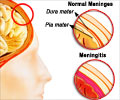Bacterial aggregates in blood vessels appear to facilitate the progression of meningococcal infection, found study.

‘Bacterial aggregates in blood vessels appear to facilitate the progression of meningococcal infection.’





A viscous liquid with original propertiesThe thick liquid nature of the aggregates depends on a virulence factor known as type IV pili. These long filaments, which have adhesive and dynamic properties, are constantly extending and retracting at the bacterial surface. The bacteria use type IV pili to find other bacteria, draw them in and temporarily establish contact. Aggregation is therefore based on an intermittent process of attraction between bacteria; in other words a constant alternation between the presence and absence of attraction. In physical terms, this intermittent process of interaction gives the aggregates original properties that had not previously been described. For example, bacteria inside aggregates exhibit a higher level of motility than that observed in the diffusion of isolated bacteria. "As well as improving our understanding of a lethal human infection, our research reveals a new type of active matter - a bacterial aggregate with a viscous, honey-like consistency - based on the intermittent attractive forces between its component parts," concludes Guillaume Duménil.
This multidisciplinary study was the result of close collaboration between a laboratory specializing in meningococcal infections (Guillaume Duménil, Institut Pasteur and Inserm) and physicists. By working with the teams led by Nelly Henry (CNRS, UPMC), Raphael Voituriez (CNRS, UPMC) and Hugues Chaté (CEA, CNRS, Paris-Saclay University), the researchers were able to combine a quantitative experimental approach with a physics-based model of active matter.
Source-Eurekalert















